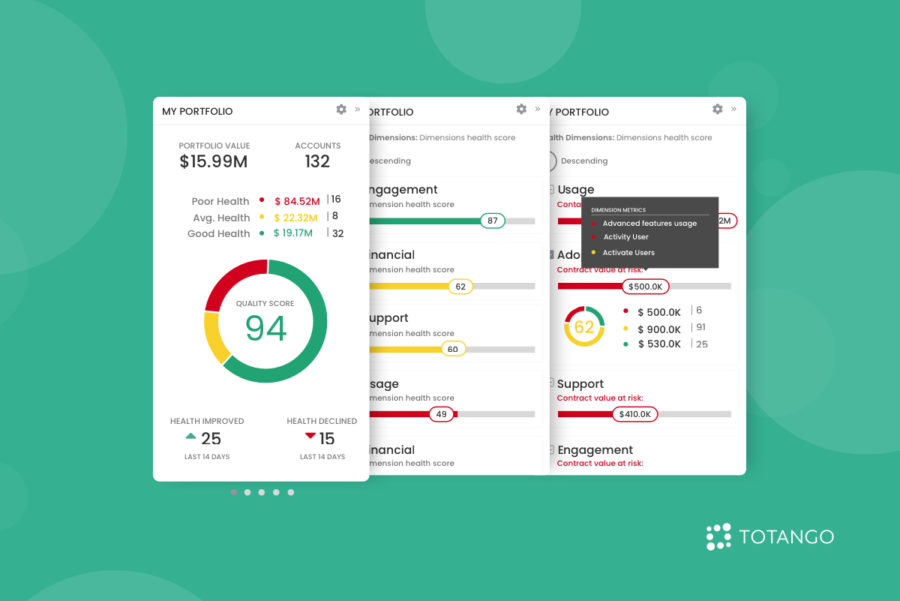Customer health is a critical component of your overall customer success program. More than just customer satisfaction, customer health software helps measure the value customers are or are not receiving from your solution, allowing you to make necessary adjustments to your overall journey. In this article, we’ll explore why customer health scores are so important, the different ways you can evaluate customer health, and how Totango can help you to build a successful customer health journey.
Why Customer Health is Important
Having an accurate understanding of customer health is the foundation of customer success. When you have a real-time, complete customer context, you are able to proactively engage with your customers and optimize the value they are receiving from your solution, which enables you to drive adoption, retention, and expansion.
Customer health is a consolidation of all the information that a company has about its customers, from all probes, people, and systems, past and present. Companies measure customer health for a variety of important reasons, including to speed up and scale communication, prioritization, decision making, and forecasting of their customer success operations. It can also be used to help companies evaluate how customer behaviors and interactions align with their business priorities and make adjustments as needed.
How to Evaluate Customer Health
When it comes to evaluating the health of a customer, there are five key indicators that are typically measured:
- Product Usage and Engagement: Are users logging in and using the application regularly? What is the volume and depth of use?
- Business Outcomes: Is the customer getting the value and end results that they signed up for?
- Service Utilization: Is the customer fully using the services/subscriptions they signed up for?
- Customer Satisfaction: What feedback are you receiving from customers in the form of CSAT, NPS, CSM sentiment, and satisfaction scores?
- Support & Operations: Does the customer have outstanding support tickets, SLA, training or invoicing issues?
Totango offers two ways to calculate and track customer health: Account Health and Multidimensional Health.
Account Health
Account Health focuses on a customer’s health score, which takes multiple dimensions of customer data metrics and classifies them into a single representation of green, yellow, or red. When a customer is green, it means they are receiving the value they need from your solution and you should continue to manage them in a similar way. When a customer is red, that means there is something wrong that requires immediate attention. A yellow score means that the customer meets some of the green criteria but not all of it and there is clear room for improvement.
This model involves building out early warning indicators that give you instant visibility into customer signals and critical events, enabling your CS team to proactively engage when needed. With this system, alerts are automatically generated about any customer who requires attention – whether there is a churn risk or an upsell opportunity. This allows your team to embrace a digital-first customer success strategy that employs automation to intercept problems and resolve them as quickly as they emerge.
With Account Health, all metrics (usage, business outcomes, utilization, satisfaction and support) are considered of equal importance, meaning that the account will only be considered in good health if all of the metrics are in good health. This way, teams are able to execute quickly and stay on top of any issues or opportunities.
Multidimensional Health
While Account Health considers all metrics equal, Multidimensional Health allows you to set weights to metrics and dimensions to fine-tune the health calculation and measure the most appropriate representations of your customers and business priorities. A weighted health model adds granularity in defining customer interactions. For instance, companies can measure the usage of a specific product feature versus just overall product usage and engagement.
The Multidimensional model reflects the diverse, unique relationships you have with your customer by allowing you to measure and define the health of your customer based on a variety of factors such as customer type, business segments and regions. Creating health definitions for each of your unique customer segments enables you to optimize your positive outreach and customer experience management. It also offers improved speed-to-outcome for CSM actions by helping them to focus their time on accounts that are most at-risk or in need of attention.
Building a Successful Customer Health Journey
Totango’s Customer Experience Canvas makes it simple and easy to map, design, build and run your customer health journey. Our new Analyze Your Customer Health SuccessBLOC gives you immediate insight into all of the health data for a given segment of accounts, including dimensional trends, dimension level and account level health statuses. It also comes preloaded with out-of-the-box tasks, campaigns and SuccessPlays to help you capitalize on good health, reduce accounts in poor health, automate tasks, and engage customers.
Ready to get started? Sign up for Totango for free and begin improving your customer health and optimizing your customer journeys today!

